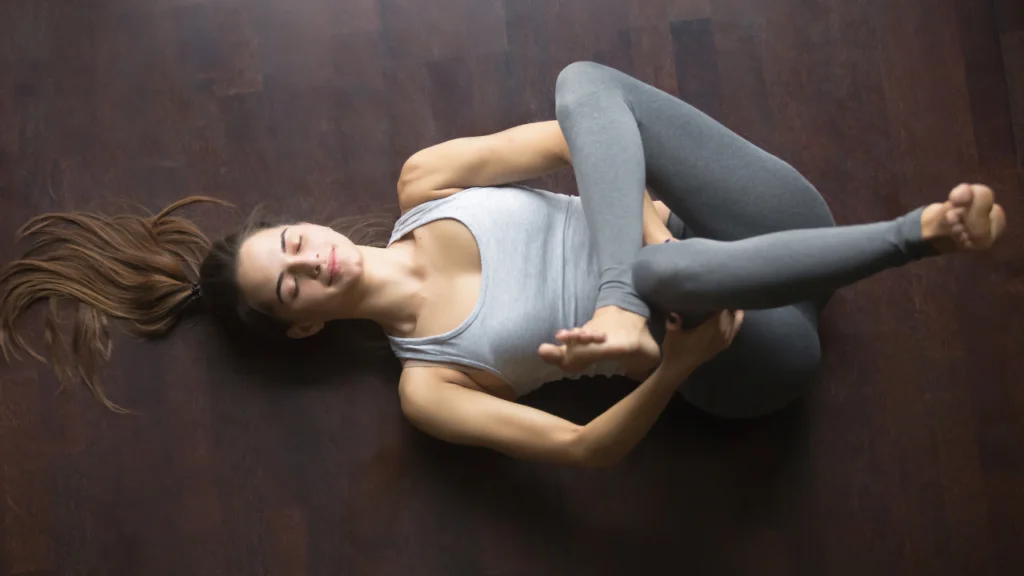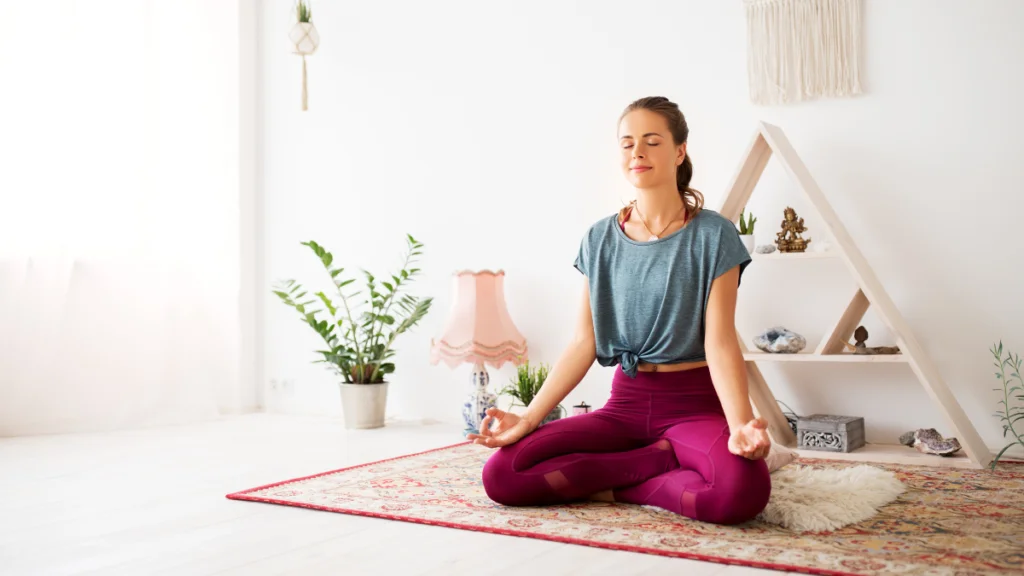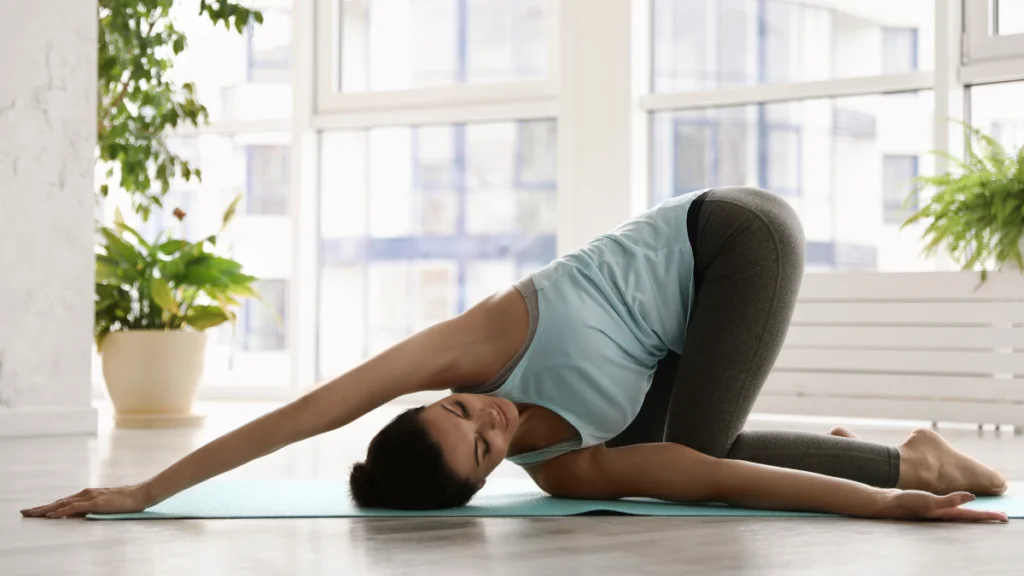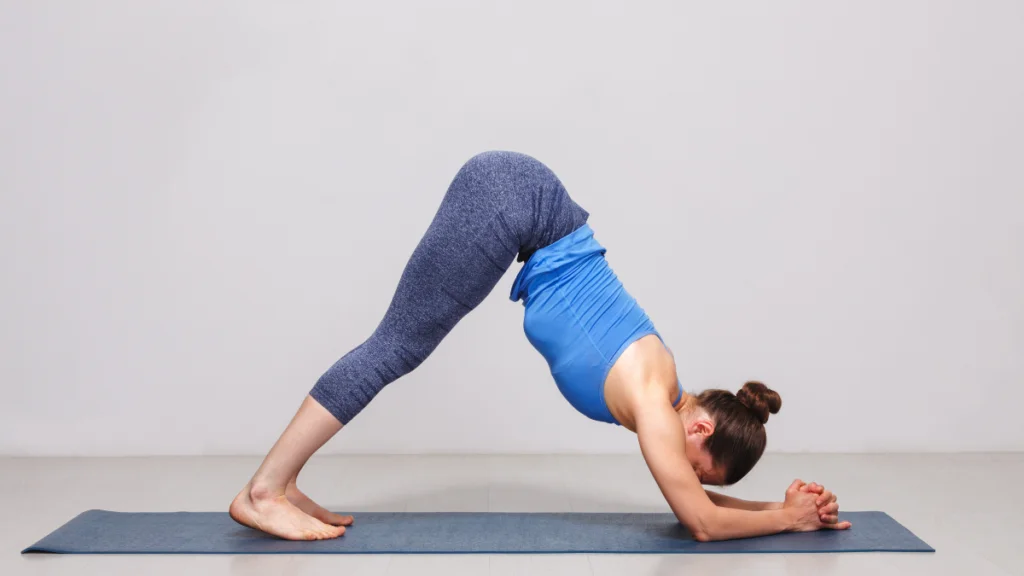
Life can often feel like a whirlwind, leaving us stressed, overwhelmed, and in desperate need of tranquility. That’s where yoga comes in. This ancient practice offers transformative benefits for stress relief and relaxation, providing a much-needed oasis of calm in our busy lives.
By incorporating yoga into your routine, you can unwind, calm your mind, and soothe your spirit, ultimately finding serenity and peace in your daily life. Through gentle stretches, mindful breathing, and meditative practices, yoga nurtures a holistic connection between your body, mind, and spirit, creating a sanctuary of relaxation and stress relief.
Key Takeaways:
- Yoga is an ancient practice that offers transformative benefits for stress relief and relaxation.
- By incorporating yoga into your routine, you can find serenity and peace in your daily life.
- Yoga nurtures a holistic connection between your body, mind, and spirit, creating a sanctuary of relaxation and stress relief.
The Importance of Restful Sleep
Restful sleep is essential for our overall well-being. In today’s fast-paced world, achieving quality sleep can be challenging. Yoga provides a gentle and effective path to unwind, let go of daily stresses, and embrace the serenity necessary for a peaceful night’s rest. It replenishes our bodies, calms our minds, and allows us to awaken with renewed vitality.
Why Quality Sleep Matters
Adequate sleep is crucial for maintaining optimal physical and mental health. It allows our bodies to repair and rejuvenate, promoting vitality and longevity. Quality sleep enhances cognitive function, concentration, and memory, boosting productivity and overall performance in daily activities.
Moreover, restful sleep bolsters our immune system, strengthens our cardiovascular health, and helps regulate hormones related to appetite and metabolism. It also contributes to emotional well-being, reducing the risk of anxiety, depression, and mood disorders.
The Role of Yoga in Achieving Quality Sleep
Yoga offers a holistic approach to improving sleep quality by addressing both the body and mind. Through a combination of gentle physical postures, breathing exercises, and meditation, yoga promotes relaxation, reduces stress, and prepares the body for restorative sleep.
The practice of yoga helps release tension and tightness in the muscles, easing physical discomfort that may hinder sleep. By engaging in deep, mindful breathing techniques, such as “pranayama,” yoga activates the parasympathetic nervous system, triggering the body’s natural relaxation response. This calms the mind, lowers stress levels, and creates an ideal environment for quality sleep.
“Yoga is the journey of the self, through the self, to the self.” – Bhagavad Gita
Specific Yoga Poses for Promoting Restful Sleep
Here are some yoga poses that can help you prepare for a night of peaceful rest:
| Yoga Pose | Benefits |
|---|---|
| Child’s Pose (Balasana) | Relaxes the body and calms the mind, relieving stress and anxiety. |
| Legs-Up-The-Wall Pose (Viparita Karani) | Reduces swelling, relieves tired legs, and induces a sense of relaxation. |
| Supine Spinal Twist (Supta Matsyendrasana) | Stretches the spine, releases tension in the back, and massages the internal organs for better digestion. |
| Corpse Pose (Savasana) | Encourages deep relaxation, eases anxiety, and prepares the body and mind for sleep. |
Including these poses in your bedtime routine can help signal to your body that it’s time to unwind and promote restful sleep. Remember to listen to your body and modify the poses according to your comfort level.
By incorporating yoga into your daily or bedtime routine, you can cultivate a state of deep relaxation, reduce sleep disturbances, and wake up feeling refreshed and rejuvenated, ready to embrace the day with vitality and energy.
Yoga – A Sanctuary of Relaxation and Stress Relief
Yoga offers more than just physical benefits; it provides a holistic approach to well-being, encompassing the body, mind, and spirit. This ancient practice creates a sanctuary of relaxation and stress relief, allowing individuals to find solace amidst the demands of daily life.
Through gentle stretches, mindful breathing, and meditative practices, yoga has the power to soothe the nervous system, release tension, and invite a profound sense of calmness into our lives. It goes beyond physical exercise, nurturing a deeper connection between the body, mind, and spirit.
The body, mind, and spirit are intricately connected, and the practice of yoga acknowledges this interconnectedness. By engaging in yoga, individuals can experience the full integration of their being, finding balance, peace, and harmony.
Yoga offers a holistic approach to relaxation and stress relief by addressing the needs of the body, mind, and spirit simultaneously. The gentle movements and postures promote physical relaxation, relieve muscular tension, and improve flexibility. The mindful breathing techniques help calm the mind, reduce anxiety, and promote mental clarity. The meditative practices cultivate a deeper connection with oneself, fostering inner peace and emotional well-being.
This body-mind-spirit connection cultivated through yoga is essential for stress relief. It allows individuals to tap into their inner resources, accessing a sense of calm and tranquility even in the midst of life’s challenges. By embracing the holistic nature of yoga, practitioners can experience a profound transformation that extends beyond the mat and into their daily lives.
The Benefits of Yoga for Relaxation and Stress Relief
When it comes to relaxation and stress relief, yoga offers a plethora of benefits. Some of the key advantages include:
- Reduced cortisol levels: Yoga helps lower the stress hormone cortisol in the body, promoting a state of relaxation and calmness.
- Improved sleep quality: The practice of yoga prepares the body and mind for restful sleep, allowing individuals to wake up feeling refreshed and rejuvenated.
- Enhanced body awareness: Through yoga, individuals develop a greater connection with their bodies, allowing them to identify and release areas of tension and stress.
- Increased self-care: Taking the time to engage in a yoga practice promotes self-care and self-nurturing, empowering individuals to prioritize their well-being.
- Emotional balance: Yoga cultivates emotional resilience, enabling individuals to manage stress, anxiety, and other emotional challenges more effectively.
With its holistic approach to relaxation and stress relief, yoga offers an effective and sustainable way to find inner peace, alleviate stress, and enhance overall well-being. By incorporating yoga into your daily routine, you can create a sanctuary for relaxation, rejuvenation, and self-discovery.
| Benefits of Yoga for Relaxation and Stress Relief |
|---|
| Reduced cortisol levels |
| Improved sleep quality |
| Enhanced body awareness |
| Increased self-care |
| Emotional balance |
It is important to note that the benefits of yoga for relaxation and stress relief are not limited to the physical body. The transformation that occurs through the practice of yoga extends to the mind and spirit, creating a profound sense of well-being and harmony.
Conquering Insomnia through Yoga
Insomnia can be a frustrating and debilitating condition that affects our sleep patterns and overall well-being. If you find yourself struggling with anxiety and sleepless nights, incorporating specific postures in your yoga practice can be a natural remedy to help you find deep and restorative sleep.
Forward folds, gentle inversions, and twists are intentional movements in yoga that encourage relaxation, release muscular tension, and create an inviting atmosphere for slumber. These postures help dissolve anxiety, quiet the mind, and prepare the body for a peaceful night’s rest.
Forward folds, such as Uttanasana (Standing Forward Bend), allow the body to release tension in the neck, shoulders, and back. This gentle inversion encourages blood flow to the head, calming the mind and promoting a sense of tranquility. It also stretches the hamstrings, reducing stiffness and promoting a relaxed state.
Gentle inversions, like Viparita Karani (Legs Up the Wall Pose), can help alleviate anxiety and insomnia. This restorative pose allows the body to unwind and the mind to quiet down. Resting the legs up the wall promotes blood circulation and relaxation, helping you find deep relaxation and peace.
Twists, such as Ardha Matsyendrasana (Half Lord of the Fishes Pose), are beneficial for releasing tension in the spine and calming the nervous system. Twists stimulate digestion, aiding in the elimination of toxins that may disrupt sleep. They also help relieve anxiety and stress, promoting a sense of calmness and tranquility.
“Incorporating specific postures in your yoga practice can be a natural remedy to help you find deep and restorative sleep.”
By practicing these specific postures regularly and with mindfulness, you can create a bedtime routine that prepares your body and mind for a peaceful night’s sleep. The intentional movements in yoga encourage deep relaxation, relieve anxiety, and quiet the mind, allowing you to conquer insomnia and experience the rejuvenation of a restful sleep.
Yoga Poses for Insomnia:
| Posture | Description |
|---|---|
| Uttanasana (Standing Forward Bend) | A gentle forward fold that releases tension in the neck, shoulders, and back. It stretches the hamstrings and promotes relaxation. |
| Viparita Karani (Legs Up the Wall Pose) | A restorative pose where you lie with your legs up a wall, promoting blood flow and relaxation. It calms the mind and relieves anxiety. |
| Ardha Matsyendrasana (Half Lord of the Fishes Pose) | A seated twist that releases tension in the spine and stimulates digestion. It helps relieve anxiety and promotes a sense of calm. |
By incorporating these poses into your yoga practice, you can create a calming and soothing routine that prepares your body and mind for a restful night’s sleep. Remember to practice mindfulness and embrace the tranquility of yoga to conquer insomnia and experience deep serenity.
Harnessing Breathwork and Meditation for Restful Nights

Breathwork and meditation are powerful tools when it comes to achieving a peaceful night’s sleep. These practices activate our body’s relaxation response, reducing stress and signaling the mind to embrace tranquility. By incorporating breathwork and meditation into your bedtime routine, you can create a serene environment that promotes deep relaxation and prepares you for restful sleep.
The Power of Breathwork
Yogic breathing techniques, such as deep belly breaths and alternate nostril breathing, have been used for centuries to calm the mind and promote relaxation. By focusing on our breath, we can tap into our body’s natural relaxation response and release tension and stress. Deep belly breaths, where we breathe deeply into our diaphragm, signal to our nervous system that it’s time to relax and let go.
Alternate nostril breathing, also known as Nadi Shodhana, is another effective breathwork technique that balances the left and right sides of the brain. It helps regulate our energy and promotes a state of calmness and tranquility. By practicing these breathwork techniques before bed, we can quiet the mind and prepare ourselves for a restful night’s sleep.
The Calming Effects of Meditation
Meditation is a practice of focusing the mind and cultivating a state of presence and awareness. It allows us to calm racing thoughts, let go of stress, and create space for relaxation. Guided meditations and visualization practices are particularly beneficial for bedtime, as they help shift our attention away from worries and into a state of deep relaxation.
During guided meditations, we are led through calming imagery and soothing affirmations that promote tranquility and peace. These meditations have been found to reduce anxiety, improve sleep quality, and enhance overall well-being. By incorporating meditation into your nightly routine, you can clear your mind, release tension, and invite a sense of deep serenity and tranquility into your sleep.
“Meditation is not a means to an end. It is both the means and the end.” – Jiddu Krishnamurti
Incorporating breathwork and meditation into your bedtime routine can have profound effects on your sleep and overall well-being. By harnessing the power of your breath and cultivating a state of presence through meditation, you can create a sanctuary of relaxation and tranquility that prepares you for restful nights and rejuvenating mornings.
Crafting a Personal Bedtime Yoga Ritual
To fully embrace the benefits of yoga for sleep, it’s important to establish a soothing bedtime ritual tailored to your needs. Set aside a few minutes each night to engage in gentle stretching, relaxation, and reflection before settling into bed. This intentional practice allows you to release tension, calm your mind, and prepare your body for deep serenity and rejuvenation during sleep.
Creating a serene ambiance in your bedroom can further enhance your bedtime ritual. Consider incorporating calming essential oils, such as lavender or chamomile, to promote relaxation. Soft lighting from a dim lamp or candles can help create a tranquil atmosphere. You can also play tranquil music or nature sounds to further immerse yourself in a state of deep serenity.
As you begin your bedtime yoga ritual, start with gentle stretches to release any residual tension in your muscles. Focus on elongating your body and finding ease in each movement. Pay attention to your breath and allow it to guide you deeper into relaxation.
Once your body feels more open and relaxed, transition into a few moments of mindful reflection. Use this time to express gratitude for the day and set positive intentions for a restful night’s sleep. You can also incorporate deep breathing exercises or a short meditation to further quiet your mind and invite a sense of calmness.
Benefits of a Bedtime Yoga Ritual:
- Reduces physical and mental tension
- Promotes relaxation and a sense of deep serenity
- Prepares the body for restorative sleep
- Enhances overall sleep quality and duration
- Supports a healthy bedtime routine
By making this ritual a regular part of your evening routine, you signal to your body and mind that it’s time to unwind and embrace a blissful night’s rest. Allow yourself to fully immerse in the practice, savoring each moment of gentle stretching, relaxation, and reflection. With a consistent bedtime yoga ritual, you can cultivate deep serenity and experience the restorative power of a peaceful night’s sleep.
Yoga Poses for Stress Relief
When it comes to finding relief from stress and promoting relaxation, practicing specific yoga poses can be incredibly effective. These poses target different areas of the body, releasing tension and cultivating a sense of calm. Incorporating these poses into your personal at-home practice can not only provide stress relief but also promote overall well-being. Here are a few yoga poses that are known for their stress-relieving benefits:
1. Eye of the Needle

The Eye of the Needle pose, also known as Sucirandhrasana, is a gentle hip stretch that helps release tension in the lower back and hips. To perform this pose:
- Start by lying on your back with your feet flat on the ground and knees bent.
- Place your right ankle on top of your left thigh, just above the knee.
- Grab a hold of the back of your left thigh and gently draw it towards your chest.
- Hold the pose for a few breaths, feeling the stretch in your right hip.
- Repeat the same steps on the other side.
2. sukhasana

Sukhasana, also known as the Easy Pose or Comfortable Pose, is a basic seated yoga posture suitable for practitioners of all levels. Here’s a step-by-step guide on how to perform Sukhasana:
- Start in a comfortable seated position: Begin by sitting on the floor or on a yoga mat with your legs stretched out in front of you.
- Cross your legs: Bend your knees and cross your legs at the shins. Bring each foot under the opposite knee. Allow your knees to drop towards the ground, bringing your feet closer to your pelvis.
- Align your spine: Sit up tall with your spine straight. Imagine your head reaching towards the sky and your tailbone rooting down into the ground. Engage your core muscles slightly to support your spine.
- Relax your shoulders: Roll your shoulders back and down, allowing your shoulder blades to gently draw towards each other. Let your arms rest comfortably on your knees or thighs.
- Place your hands: Rest your hands on your knees with your palms facing down for grounding energy or palms facing up for a more open and receptive energy. Alternatively, you can place your hands in a mudra position such as chin mudra (thumb and index finger touching) or Gyan mudra (thumb and index finger touching with other fingers extended).
- Close your eyes: Softly close your eyes or maintain a gentle gaze downwards if that feels more comfortable for you.
- Relax and breathe: Take slow, deep breaths, filling your lungs completely with each inhale and exhaling fully with each exhale. Allow any tension in your body to melt away as you settle into the posture.
- Hold the pose: Remain in Sukhasana for as long as feels comfortable, maintaining a steady breath and relaxed posture.
- Release: To release the pose, gently uncross your legs and extend them out in front of you. Shake out your legs if needed before transitioning into your next posture or activity.
Remember to listen to your body and make any necessary adjustments to ensure you feel comfortable and supported in Sukhasana. With regular practice, you’ll find this pose becomes easier and more comfortable over time.
3. Thread the Needle

Thread the Needle, or Parsva Balasana, is a gentle shoulder-opening pose that helps release tension in the upper back and shoulders. Here’s how to do it:
- Start on all fours in a tabletop position.
- Extend your right arm under your left arm, threading it through the space between your left arm and left knee.
- Rest your right ear and shoulder on the mat.
- Hold this pose for a few breaths, feeling the stretch in your right shoulder.
- Repeat on the other side, threading your left arm under your right arm.
4. Open Wing Pose

The Open Wing pose, or Ardha Pincha Mayurasana, is a calming pose that helps relieve tension in the neck, shoulders, and upper back. Follow these steps to practice this pose:
- Start in a tabletop position with your hands and knees on the mat.
- Walk your hands forward, keeping your hips above your knees.
- Lower your forearms to the mat, extending them in front of you.
- Spread your fingers wide and relax your neck and shoulders.
- Take slow, deep breaths and allow your body to relax into the pose.
These are just a few of the many yoga poses that can help you find relief from stress and promote relaxation. Incorporating these poses into your personal practice can have a profound impact on your physical and mental well-being. Explore different poses and find the ones that resonate with you the most. Remember, consistency is key when it comes to reaping the full benefits of yoga for stress relief.
The Benefits of Yoga for Stress Relief

Yoga offers countless benefits for stress relief. By incorporating yoga into your routine, you can experience a profound decrease in stress levels, allowing for increased peace and relaxation in your daily life.
Lowered Cortisol Levels
One of the significant benefits of yoga is its ability to lower cortisol levels in the body. Cortisol is known as the stress hormone and is responsible for triggering the body’s stress response. Practicing yoga regularly helps regulate cortisol levels, reducing the impact of stress on your body and mind.
Improved Sleep
In addition to stress relief, yoga also improves sleep quality. By engaging in calming and restorative yoga postures, coupled with mindful breathing techniques, you can create a conducive environment for restful sleep. Yoga helps calm the mind, release tension, and promote relaxation, allowing you to achieve a more restorative sleep.
Enhanced Digestion
Yoga has been found to support healthy digestion. The gentle movements and stretches involved in yoga help stimulate the digestive system, improving nutrient absorption and reducing digestive discomfort. By incorporating yoga into your routine, you can promote a healthy digestive system, contributing to overall well-being.
Boosted Immune System
Regular yoga practice has been shown to have a positive impact on the immune system. By reducing stress and improving sleep quality, yoga helps strengthen the immune system, making you less susceptible to illnesses and infections. A strong immune system is essential for maintaining optimal health and well-being.
“Yoga is a holistic practice that not only targets physical fitness but also offers remarkable benefits for stress relief and overall well-being. It allows for a harmonious connection between the body, mind, and spirit, creating a sanctuary of relaxation and serenity.”
By incorporating yoga into your life, you not only gain physical flexibility and strength but also experience the transformative benefits of stress relief, improved sleep, enhanced digestion, and a resilient immune system. Embrace the practice of yoga to cultivate tranquility and find solace in the fast-paced world we live in.
| Benefits of Yoga for Stress Relief | Summary |
|---|---|
| Lowered Cortisol Levels | Reduces the stress hormone cortisol, promoting a state of relaxation. |
| Improved Sleep | Enhances sleep quality, allowing for restorative rest and rejuvenation. |
| Enhanced Digestion | Supports a healthy digestive system, improving nutrient absorption and reducing discomfort. |
| Boosted Immune System | Strengthens the immune system, reducing susceptibility to illnesses and infections. |
Conclusion
Yoga for stress relief is a powerful practice that can bring serenity and peace into your life. By incorporating yoga into your routine, you can experience the transformative power of this ancient practice in relieving stress, fostering relaxation, and preparing your body and mind for a night of deep and rejuvenating sleep.
Take a moment to embrace the tranquility of yoga and let it guide you towards a world of peaceful dreams and restful slumber. With its holistic approach and focus on the body-mind-spirit connection, yoga offers numerous benefits for your overall well-being. It not only helps lower cortisol levels, the stress hormone, in the body but also improves sleep quality, digestion, and the immune system.
By making yoga a regular part of your life, you equip yourself with the tools to manage daily stress and navigate emotionally challenging situations with grace. So, why not start your yoga journey today and experience the serenity, peace, and relaxation it can bring to your life?
FAQ
What is yoga for stress relief?
Yoga for stress relief is a practice that incorporates gentle stretches, mindful breathing, and meditative practices to soothe the nervous system, release tension, and invite a profound sense of calmness into our lives.
How does yoga promote restful sleep?
Yoga provides a gentle and effective path to unwind, let go of daily stresses, calm the mind, and cultivate serenity necessary for a peaceful night’s rest. It replenishes our bodies, calms our minds, and allows us to awaken with renewed vitality.
What is the holistic approach of yoga?
Yoga goes beyond its physical aspects and offers a holistic approach to well-being. It cultivates a harmonious connection between the body, mind, and spirit, providing a sanctuary of relaxation and stress relief.
How can yoga help with insomnia?
Yoga offers specific postures like forward folds, gentle inversions, and twists that can dissolve anxiety, quiet the mind, and prepare our bodies for deep and restorative sleep. These intentional movements encourage relaxation, release muscular tension, and create an inviting atmosphere for slumber.
How do breathwork and meditation help with sleep?
Breathwork and meditation activate our body’s relaxation response, reducing stress and signaling the mind to embrace tranquility. Yogic breathing techniques, such as deep belly breaths and alternate nostril breathing, along with guided meditations and visualization practices, calm racing thoughts and provide a gentle transition into a state of deep relaxation, where sleep can find us effortlessly.
How can I create a bedtime yoga ritual?
To establish a soothing bedtime ritual, set aside a few minutes for gentle stretching, relaxation, and reflection before settling into bed. Create an ambiance with calming essential oils, soft lighting, and tranquil music to nurture deep serenity. Make this ritual a regular part of your evening routine to signal your body and mind that it’s time to unwind and embrace a blissful night’s rest.
Where can I find online yoga classes for stress relief?
If you’re feeling overwhelmed by the stresses of daily life, online yoga classes specifically designed for stress relief can be a valuable resource. These classes provide the tools and techniques you need to combat stress and promote deep relaxation, whether you’re a beginner or an experienced practitioner.
What are some yoga poses for stress relief?
Specific yoga poses such as Eye of the Needle, Bananasana, Thread the Needle, and Open Wing Pose target different areas of the body to release tension and cultivate a sense of calm. These poses can be incorporated into a personal at-home practice to find relief from stress and promote overall well-being.
What are the benefits of yoga for stress relief?
Yoga lowers cortisol levels, the stress hormone, in the body and improves sleep, digestion, and the immune system. The practice also helps ease depression, sadness, and mood swings, making individuals more equipped to manage daily stress and emotionally challenging situations.
Source Links
- https://www.yogapodsaigon.com/pod-blog/unwind-and-sleep-tight-embrace-serenity-with-yoga-for-a-restful-nights-sleep
- https://yogaselection.com/yoga-for-stress-relief-7-classes-to-calm-your-mind-and-relax-your-body/
- https://www.yogajournal.com/poses/yoga-by-benefit/stress/yoga-poses-for-stress-relief/

Welcome! I’m Luke, a certified personal trainer with over 14 years of experience. With a BSc (Hons) in Sports Science, I specialize in tailored fitness programs for diverse clients who want to improve their lifestyle through exercise and healthy eating.

